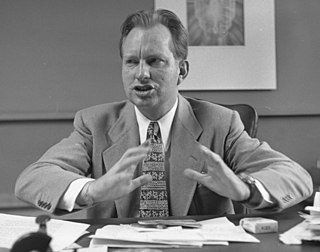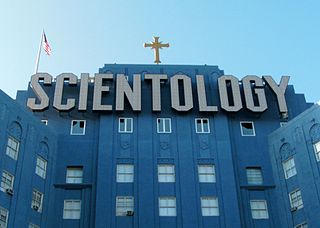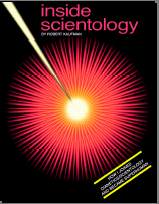
Dianetics is a set of ideas and practices, invented in 1950 by science fiction writer L. Ron Hubbard, regarding the human mind. Dianetics was originally conceived as a form of psychological treatment, but was rejected by the psychological and medical establishments as pseudoscientific. It was the precursor to Scientology and has since been incorporated into it. It involves a process referred to as "auditing", which utilizes an electrical resistance meter, ostensibly to remove emotional burdens and "cure" people from their troubles.

Lafayette Ronald Hubbard was an American author and the founder of Scientology. A prolific writer of pulp science fiction and fantasy novels in his early career, in 1950 he authored Dianetics: The Modern Science of Mental Health and established organizations to promote and practice Dianetics techniques. Hubbard created Scientology in 1952 after losing the intellectual rights to his literature on Dianetics in bankruptcy. He would lead the Church of Scientology – variously described as a cult, a new religious movement, or a business – until his death in 1986.

The E-Meter is an electronic device used in Scientology that allegedly "registers emotional reactions". After claims by L. Ron Hubbard that the procedures of auditing, which used the E-Meter, could help heal diseases, the E-Meter became the subject of litigation. Since then, the Church of Scientology publishes disclaimers declaring that the E-Meter "by itself does nothing", is incapable of improving health, and is used solely for spiritual purposes.

The Mind Benders was written by Cyril Vosper, a Scientologist of 14 years who had become disillusioned, Published in 1971 and reprinted in 1973, it was the first book on Scientology to be written by an ex-member and the first critical book on Scientology to be published. It describes the lower levels of Scientology and its philosophy in detail and also includes the story of Vosper's expulsion from the Church.

Scientology ethics and justice are a collection of policies and procedures by L. Ron Hubbard and used by the Church of Scientology. Scientology defines ethics as "the actions an individual takes on himself", and justice as "the action taken on the individual by the group when he fails to take these actions himself". The body of writings include techniques and policies of moral choices, and the rules of conduct to be followed by scientologists.
When the individual fails to put in his own ethics, the group takes action against him and this is called justice.
Scientologie, Wissenschaft von der Beschaffenheit und der Tauglichkeit des Wissens is a 1934 book published by Anastasius Nordenholz, in which he defines the term "Scientologie" or "Eidologie" as a science of knowing or knowledge and discusses the philosophical implications of the concept.

Ronald Edward "Ron" DeWolf, also known as "Nibs" Hubbard, was the eldest child of Scientology's founder L. Ron Hubbard by his first wife Margaret Louise Grubb. He is known for having been highly critical of his father and of the Church of Scientology. In his opinion, Scientology was a cult that existed to make money.

History of Dianetics and Scientology begins around 1950. During the late 1940s, L. Ron Hubbard began developing a mental therapy system which he called Dianetics. Hubbard had tried to interest the medical profession in his techniques, including the Gerontological Society, the Journal of the American Medical Association, and the American Journal of Psychiatry, but his work was rejected for not containing sufficient evidence of efficacy to be acceptable.

A Piece of Blue Sky: Scientology, Dianetics and L. Ron Hubbard Exposed is a 1990 book about L. Ron Hubbard and the development of Dianetics and Scientology, authored by British former Scientologist Jon Atack. It was republished in 2013 with the title Let's sell these people A Piece of Blue Sky: Hubbard, Dianetics and Scientology. The title originates from a quote of Hubbard from 1950: an associate of Hubbard's noted him saying that he wanted to sell potential members "a piece of blue sky".
Para-Scientology is a branch of Scientology which deals with all things unknown.

This bibliography of Scientology includes Scientology and Dianetics-related books, periodicals and other issues authored by L. Ron Hubbard and those produced by the Church of Scientology and its related organizations. Books bearing L. Ron Hubbard's name are considered texts of Scientology's canon.
The amount of material on Dianetics and Scientology is extensive, to say the least. This material is composed of books by L. Ron Hubbard ; compilations of his works; taped lectures; auditor training materials ; course packages; booklets; a large number of magazines and annuals; and video recordings of the major annual events.

The Scandal of Scientology is a critical exposé book about the Church of Scientology, written by Paulette Cooper and published by Tower Publications, in 1971.

Inside Scientology: How I Joined Scientology and Became Superhuman is a 1972 book by Robert Kaufman, in which the author takes a critical look at the Church of Scientology. It was first published in 1972 by Olympia Press. The book was the first to disclose secret Scientology materials. It was also published in 1972 in German, and was the first extensive critical report on Scientology in German.

An incident in Scientology beliefs is something that happened to a person that continues to have a grip on their mind or spirit, and is negatively affecting them. It could be an accident or traumatic event that includes pain and subconscious commands, whether from this life or in past lives. Scientology auditing procedures are used to locate incidents in the mind, and relieve them.

The intersection of Scientology and abortion has a controversial history which began with Scientology founder L. Ron Hubbard's discussion of abortion in his 1950 book Dianetics: The Modern Science of Mental Health. Hubbard wrote in Dianetics that abortion and attempts at abortion could cause trauma to the fetus and to the mother in both spiritual and physical ways. Scientologists came to believe that attempted abortions could cause traumatic experiences felt by the fetus, which would later be remembered as memories referred to in Scientology as "engrams". In the Scientology technique called Auditing, Scientologists are frequently queried regarding their sexual feelings and behaviors. These questions about Scientologists' sexual behavior are often posed to members during "security checks", a specific form of auditing sessions where individuals are required to document their divergence from the organization's ethics. One of the questions asked in these security checks is, "Have you ever been involved in an abortion?".

The Advanced Ability Center was a breakaway organization from the Church of Scientology established by former Scientologist David Mayo after he left the Church in February 1983, a time when most of Scientology's upper and middle management was removed following the formation of the Religious Technology Center (RTC) and RTC head David Miscavige's restructuring of the church. David Mayo had been Hubbard's own auditor. The Advanced Ability Center later became the Theta International movement and was also known as the Church of the New Civilization.

Scientology is in part derived from, and shares elements with, a number of esoteric or occult systems. The extent of the influence of specific occult belief systems on Scientology is a subject of debate amongst scholars.
This is a bibliography of works critical of Scientology and the Church of Scientology.
From 1950 to 1953, Hubbard led the Dianetics Movement which published, promoted and provided an alternative talk therapy called "auditing".











